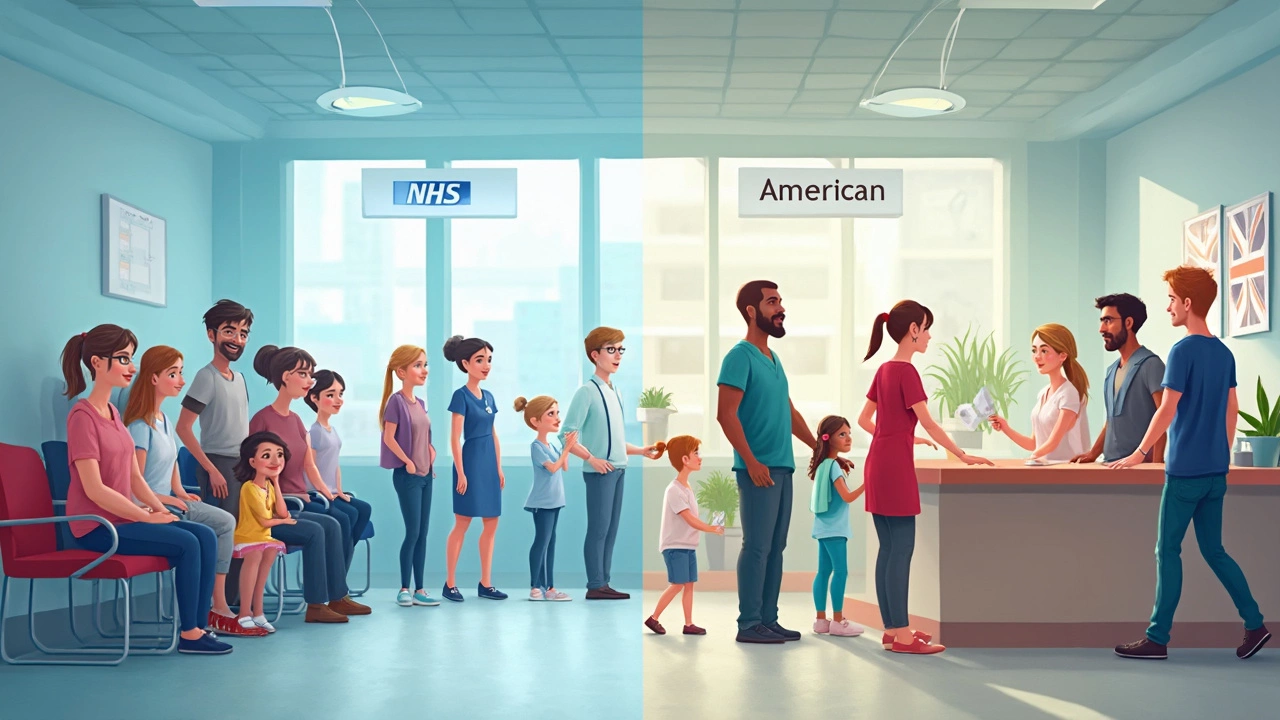 Jun, 12 2025
Jun, 12 2025
Picking between the US and UK healthcare systems can feel like one of those debates where nobody ever really wins, but you don’t want to make the wrong choice—especially when your health or your kid’s health is at stake. In the US, you’re hit with complicated insurance plans, quarterly bills, and the classic 'can I afford to go to the doctor?' panic. In the UK, the NHS is kind of a point of national pride, but you might wonder about those waiting lists or if you’ll be stuck in a queue when your kid, like Jasper, wakes up with a fever you just can’t ignore.
Until you actually need care, it’s tempting to think one system is obviously better. But things get muddy fast. The US spends way more per person—over $12,000 a year according to 2024 government health data—while the UK spends less than half that, thanks to tax-funded care. On paper, that’s a massive gap, but does it mean better results? Americans argue you get faster treatment, top-notch hospitals, and choices galore. Brits will say, 'I never get a bill for breaking my leg. Who needs paperwork?' The truth is, each model has trade-offs that hit you differently depending on your age, job, family size, and even where you live.
If you’re weighing which country’s healthcare is actually better, you’ve got to look past the headlines and stories from that one guy in your gym. Think about what it means for your day-to-day life: How fast can you see a GP? How high are your surprise bills? How does coverage change if you lose your job, move abroad, or need meds every month? It’s about what happens when real people run into real health problems.
- How the US and UK Pay for Healthcare
- Access to Doctors and Hospitals
- What Happens in an Emergency
- Out-of-Pocket Costs and Insurance Fine Print
- Real-World Tips for Expats and Travelers
How the US and UK Pay for Healthcare
The way people pay for care in the US and UK is almost completely opposite. In the US, you deal with private insurance plans, complicated paperwork, and a pile of bills—unless you qualify for government programs like Medicare or Medicaid. In the UK, the system is a lot simpler: you're covered under the NHS, which is paid for by taxes. You don’t hand over a card every time you see a doctor, and you usually don’t see a charge at all unless you go private or need extras like some dental work or prescriptions.
Here's the main setup in both countries:
- US healthcare system: Most people get insurance through their employer, and pay monthly premiums, plus copays or deductibles when they need care. If you’re self-employed or jobless, there’s the public marketplace (think "Obamacare"), but it’s far from cheap.
- UK healthcare system: The NHS covers everyone who lives in the UK full-time. There’s no bill at the point of use for doctor visits or hospital stays, and you don’t lose insurance if you switch jobs.
Check out how the numbers actually compare:
| Country | Average Healthcare Spend per Person (2024) | % Covered by Public Funding | Out-of-Pocket Costs for GP Visits |
|---|---|---|---|
| US | $12,555 | 49% | Varies (usually $25-$75 or more with insurance) |
| UK | $5,292 | 78% | £0 (NHS covers it) |
So what does this actually mean when you get sick or need regular appointments? In the US, even with solid insurance, you might get random bills for seeing a specialist, getting bloodwork, or receiving treatment at a hospital out of your network (which isn't always obvious until you check your mailbox). In the UK, you’ll mostly avoid these worries. You can just see your local doctor or go to the hospital, and most of the time your wallet doesn’t even leave your pocket.
Keep in mind: about 10% of Brits buy extra private insurance mainly for faster access or nicer hospital rooms, but almost no one has to. In the US, if you don’t have insurance, you’re risking giant bills even for minor issues. That difference shapes how families—like mine—think about moving or traveling between these countries.
Access to Doctors and Hospitals
The biggest difference between the US and UK healthcare systems is how you actually get in to see a doctor or specialist. Ask anyone who's done both: it's not just about cost, it's about how fast you can get what you need, in the place you want.
In the US, you usually pick your primary care physician (PCP) from a network provided by your insurer. Want a specialist? Most insurance plans make you get a referral, but some let you call up anyone in-network. The upside? In non-rural areas, appointments with regular doctors can often be booked for the same or next day, especially if you have good insurance. Private hospitals can feel like checking into a hotel, and waiting times for things like MRIs or surgeries—if your insurance covers it—are often short. But there’s a catch. If you don’t have insurance, or if you’re on a high-deductible plan, you might think twice before booking anything.
Now the UK side: everyone’s registered with a local GP (general practitioner) and sees that doctor for everything at first. GPs act as gatekeepers for most specialist care. The upside is obvious: it’s free at the point of use. No bills, no arguing with insurers, no hunting for who’s "in network". Downside: GPs can be busy. It’s not rare to wait a week or more for a routine appointment, though urgent or pediatric cases usually get squeezed in faster. If you need to see a specialist, you’ll need a GP referral, and that can mean weeks or even months for non-life-threatening issues.
Want some actual numbers? There’s a known stat from 2023: in the UK, 44% of people waited a week or more to see a GP, while in the US, only 24% had to wait that long for a primary doctor. For specialist care, Americans average about 4 weeks for non-urgent referrals, while NHS patients can wait twice that unless it’s urgent. Emergency care in the UK is free and quick for real emergencies, but for less urgent stuff, you can end up waiting hours.
Here’s a quick hit list if you’re comparing:
- In the US, insurance type decides which hospitals and doctors you can use, and you pay for most visits unless you hit your deductible.
- In the UK, you get assigned a local GP, and you rarely see medical bills except for some dental and eye care.
- The US has more private hospitals per capita, while the UK's NHS controls the bulk of the system—private insurance does exist, but most people don’t buy it unless they want faster access.
- If you need treatment fast and you have good insurance, the US often wins on speed. For routine care, the NHS is predictable and avoids surprise costs.
This table lays out the basics side-by-side:
| US | UK (NHS) | |
|---|---|---|
| Primary Care Wait (avg.) | 1-3 days (insured) | 5-8 days |
| Specialist Wait (avg.) | ~4 weeks | ~8 weeks |
| Emergency Room Cost | Often over $1,000 (with insurance deductibles) | Free for everyone |
| Choice of Doctor | Depends on your plan | GP assigned by location, some can pick |
| Private Hospitals | Common, can cost more | Rare, most use NHS |
If you’re moving or traveling, don’t assume you’ll have the same access everywhere. The healthcare insurance UK system protects you from surprise costs but may test your patience. In the US, you’ll often get faster care—if your insurance covers it, and if you can stomach the cost.

What Happens in an Emergency
Here’s where things get real. If you break your arm, have a sudden chest pain, or your kid ends up with a nasty allergic reaction, you want to know help is right there—and that you won’t be buried in bills afterwards. The way emergencies are handled is one of the biggest differences between the US and UK healthcare systems.
In the UK, you call 999 or head straight to A&E (Accident & Emergency). No one asks about your insurance. If you live there or are visiting, treatment is free at the point of use. That means even if you end up needing a CT scan or a night in the hospital, you won’t get a bill the size of a new car. For non-residents or some specific treatments, there could be charges, but the basics (like emergencies) are always covered. NHS England says,
"Accident and Emergency departments are open 24 hours a day, 365 days a year and are free to use for anyone needing emergency treatment."
In the US, it’s a bit more stressful. You’ll call 911 or go to the nearest ER. You’ll get treated quickly if it’s a true emergency, but the paperwork and insurance questions start almost as soon as you’re through the doors. The pain starts again when the bills show up later. According to a 2023 report by the Kaiser Family Foundation, the average ER visit costs an insured patient about $1,200 out-of-pocket. The uninsured can get hit with bills that run into the tens of thousands, depending on what’s done.
Here’s a quick look at how emergency care compares:
| Country | Emergency Number | Avg. Wait (Non-life-threatening) | Typical Out-of-Pocket Cost |
|---|---|---|---|
| UK (NHS) | 999 | 4+ hours in high-demand A&Es | Usually £0 (for residents) |
| US | 911 | 15-90 minutes | $1,200+ for insured; much more if uninsured |
It’s worth mentioning that NHS hospitals do deal with crowding, so waits for non-serious issues can drag on, especially on busy weekends. In the US, you’ll usually get seen faster, but the cost is what really gets you, especially if you don’t have strong insurance. Also, keep in mind that ambulance rides aren’t free in the US—something as simple as calling 911 might come with a hefty fee.
A practical tip for travelers: if you’re in the US and don’t have insurance, try urgent care clinics for less-serious injuries or illnesses—they’re often quicker and cost much less than the ER. In the UK, if you’re not dealing with a true emergency, you should call NHS 111 first for advice and triage. Both countries have their quirks, so knowing what to expect before something bad happens can save a lot of pain, both physically and for your bank account.
Bottom line: the healthcare system US and UK both come through in a life-or-death crisis, but what happens after could seriously impact your stress levels and finances.
Out-of-Pocket Costs and Insurance Fine Print
If you’re used to the healthcare system US vibe, brace yourself: bills in America can be unpredictable and seriously expensive. Even with decent insurance, you’ll probably deal with monthly premiums, deductibles (that’s the amount you pay before insurance kicks in), co-pays for each visit, and coinsurance (a percentage of the bill, usually for bigger stuff like hospital stays). A typical family plan in 2024 had an average monthly premium of $1,154, according to Kaiser Family Foundation. High deductibles—$2,500 or more—are common, and out-of-pocket max can climb to $8,000 per person. Miss a payment, or go out of network, and things get ugly fast.
The UK flips this. The NHS covers hospital stays, GP visits, even ambulance rides—no invoices after you leave the ER. You won’t get a bill for having a baby or getting a cast. The only real "out-of-pocket" costs for most folks are prescription charges (about £9.90 per item in 2025), dental care, and eye tests, unless you’re under 18, over 60, or have one of several exemptions. There’s also the option of private insurance in the UK, but most Brits don’t carry it; only around 12% do, picking it for quick access to specialist care or private rooms.
| Cost Type | US (2024) | UK (2025) |
|---|---|---|
| Monthly Insurance Premium (Family Avg.) | $1,154 | N/A (NHS is tax-funded) |
| Annual Deductible (Family Avg.) | $2,500+ | N/A |
| Doctor Visit Copay | $25–$75 | £0 (NHS) |
| Emergency Visit | $100–$2,000+ | £0 (NHS) |
| Prescription (per item) | $10–$100 | £9.90 |
If you get your US insurance through work, check the coverage details obsessively. Some plans refuse certain treatments, or slap you with "out-of-network" charges if you blink wrong. If you’re self-employed, premiums are even worse unless you qualify for subsidies. On the NHS side, always double-check what’s exempted if you’re taking regular meds—the prepay certificate can save serious cash.
- Read all the paperwork. Bold claims on "everything covered" often hide exceptions—especially in the US.
- Save every bill and EOB (Explanation of Benefits) until claims settle.
- For frequent meds in the UK, ask about the Prescription Prepayment Certificate—it’s usually cheaper if you need more than one script a month.
- Traveling? Always get travel medical insurance; US coverage rarely works abroad, and NHS doesn’t help in another country.
In short, US healthcare is all about knowing your limits, literally. In the UK, unless you fall into the few private gaps, what you see is mostly what you get. The biggest shock? Americans are often floored by the simplicity of the NHS, while Brits can’t believe the bills Americans accept as normal.

Real-World Tips for Expats and Travelers
If you're headed from the US to the UK or vice versa, forget the idea that you can just walk into a doctor’s office like you do at home. The rules change fast, and one mistake can leave you stuck with a big bill—or no care at all.
Coming from the US and thinking of living in the UK? As a resident, you’re usually eligible to use the NHS, but you need to register with a local GP as soon as you get a UK address. Your NHS number won’t appear overnight and you can’t just pop in for a check-up without that GP registration. Kids like Jasper count as dependents, so make sure their paperwork is sorted too. NHS covers most treatments, but don’t expect everything to be free—prescriptions in England still have a flat charge (currently £9.90 per item in 2025), though kids, seniors, and some conditions are exempt.
If you’re just visiting the UK on holiday, US travel health insurance is a must, because the NHS can charge non-residents for most non-emergency treatments. Emergency rooms won’t turn people away, but for anything less urgent—like a twisted ankle or strep throat—you could get billed if you can’t prove residency or citizenship. Bring those insurance cards and know your policy details before you hop on that plane.
Now, for Brits moving to the US, you need to understand how the healthcare system US side works. There’s no universal coverage, and even quick visits to urgent care can cost hundreds of dollars without health insurance. Travel insurance might cover emergencies, but settling down or working in the US means picking a plan—usually through your job, or private policies if you’re self-employed. Don’t skip coverage between jobs; COBRA or short-term plans are lifesavers, even if they feel pricey.
Here are a few practical tips to avoid headaches:
- Always carry proof of insurance—either a plastic card or digital app.
- Read your policy’s small print. You’d be surprised what isn’t covered, especially pre-existing conditions or routine care.
- Know the nearest in-network hospitals before you go, not after an accident. Out-of-network US hospitals can charge ten times more than NHS hospitals for the same thing.
- If you take regular medication, bring extra—both countries have strict prescription rules, and your US script won’t work in a UK pharmacy (and vice versa).
- For parents: bring your kid’s medical records. Schools and doctors in both the US and UK ask for immunization proof before enrollment or appointments.
Stuff goes wrong on the road or when settling in. Make it easier on yourself by knowing the basics. Don’t bet your bank account on good luck—do a little homework before you travel and you’ll avoid the most common pitfalls.
